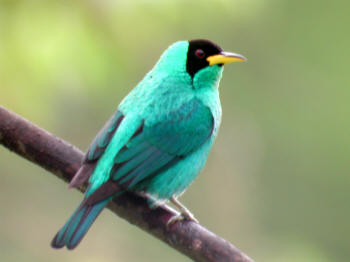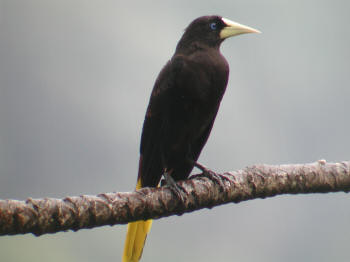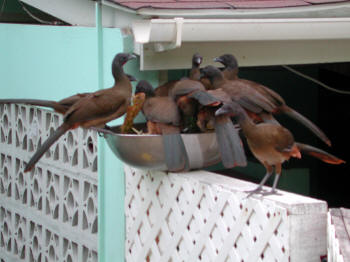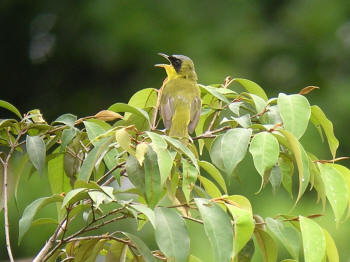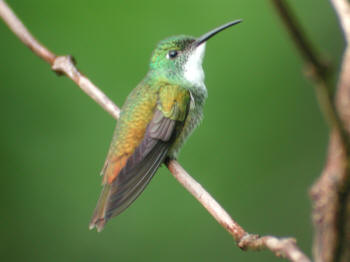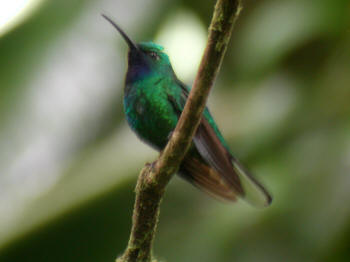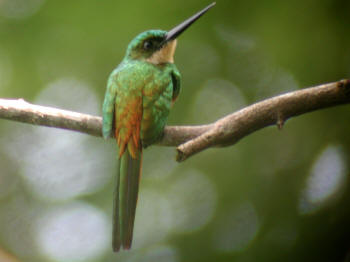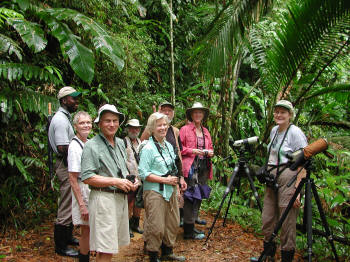CBC's Trinidad and Tobago Trip a Great Success
By Bill Sugg
| Click on any photo for larger image. |
Oilbirds, tropicbirds, motmots, trogons, antbirds, bellbirds. The list of tropical exotics could go on and on. All can be seen up close and personal when visiting the islands of Trinidad and Tobago. This island nation is just off the northeastern coast of South America, near Venezuela.
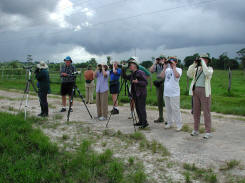
|
|
Simon Thompson |
|
Group at Aripo Savanna |
On Trinidad our base was the Asa Wright Nature Centre at 1,200 feet above the Arima Valley. We walked the trails on the Centre grounds and took van excursions to explore an incredible variety of habitats in the valley and on the coast.
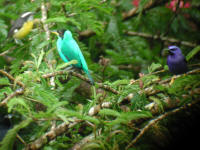
|
|
Simon Thompson |
|
Threesome: Bananaquit, Green Honeycreeper, Purple Honeycreeper |
Asa Wright has a special place on its grounds: Dunstan Cave, one of the most accessible sites in the world to see Oilbirds. These large-with a wingspan of 3.5 feet-nocturnal fruit-eaters roost there. This bird leaves the roost at dusk and, navigating by a sort of sonar, finds his food by smell and hovers over the fruit to eat it.
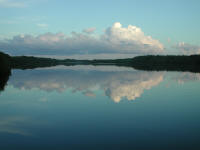
|
|
Simon Thompson |
|
Evening at Caroni |
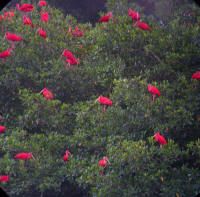
|
|
Lucy Quintilliano |
|
Scarlet Ibis |
Toward dusk they began arriving. First in small numbers, twos, and threes. Then the numbers expanded until it seemed the whole sky was full of flapping scarlet. Hundreds, thousands of Scarlet Ibis were coming to an island in a Caroni Swamp lake. The ibis were joined by hundreds of Tricolored Herons that roost on the same island.
Tobago was only a short flight away. Unfortunately, severe rainstorms just before our arrival hit Tobago, which was recovering from hurricane Ivan. Mudslides throughout the eastern part of the island were very serious and presented a major obstacle to travel by foot and by vehicle. The Blue Water Inn, on the northeast tip of the island, was our base. We found Blue-crowned Motmots roosted on the lights of some of the rooms' balconies.
From the Inn it was just a short boat ride to Little Tobago Island to see nesting Red-billed Tropicbird and Red-footed Booby. At Bon Accord lagoon we had good views of Little Egret as well as Blue-black Grassquit and Red-crowned Woodpecker. A couple of days later, in Gilpin Trace in the Main Ridge Forest Preserve we saw White-tailed Sabrewing and Collared Trogon.
On the last night we tallied up the trip totals and came up with 198 species. Two more were added the next morning at a brief stop on the way to the airport: Ring-necked Duck and Green Heron. Grand total: 200!
Thanks to the Carolina Bird Club for its sponsorship of these extralimital trips!
Species seen |
||
|---|---|---|
|
Least Grebe Red-billed Tropicbird Magnificent Frigatebird Masked Booby Red-footed Booby Brown Booby Anhinga Brown Pelican Black-bellied Whistling-Duck American Wigeon White-cheeked Pintail Blue-winged Teal Ring-necked Duck Tricolored Heron Little Blue Heron Snowy Egret Little Egret Great Blue Heron Great Egret Cattle Egret Striated Heron Green Heron Yellow-crowned Night-Heron Black-crowned Night-Heron Scarlet Ibis Black Vulture Turkey Vulture Osprey Pearl Kite Double-toothed Kite White Hawk Common Black-Hawk Great Black-Hawk Savanna Hawk Grey Hawk Broad-winged Hawk Short-tailed Hawk Zone-tailed Hawk Ornate Hawk-Eagle Yellow-headed Caracara Merlin Peregrine Falcon Red Junglefowl Rufous-vented Chachalaca Purple Gallinule Common Moorhen Limpkin Wattled Jacana Whimbrel Greater Yellowlegs Solitary Sandpiper Spotted Sandpiper Ruddy Turnstone Sanderling Least Sandpiper White-rumped Sandpiper Semipalmated Plover Southern Lapwing Royal Tern Common Tern Rock Pigeon Scaled Pigeon Pale-vented Pigeon Eared Dove Ruddy Ground-Dove White-tipped Dove |
Grey-fronted Dove Red-bellied Macaw Green-rumped Parrotlet Lilac-tailed Parrotlet Yellow-crowned Parrot Orange-winged Parrot Squirrel Cuckoo Smooth-billed Ani Striped Cuckoo Tropical Screech-Owl Ferruginous Pygmy-Owl Oilbird Common Potoo Common Pauraque White-tailed Nightjar Grey-rumped Swift Short-tailed Swift Fork-tailed Palm-Swift Rufous-breasted Hermit Green Hermit Little (Stripe-throated) Hermit White-tailed Sabrewing White-necked Jacobin Green-throated Mango Black-throated Mango Tufted Coquette Blue-chinned Sapphire White-chested Emerald Copper-rumped Hummingbird White-tailed Trogon Collared Trogon Violaceous Trogon Belted Kingfisher Green Kingfisher Blue-crowned Motmot Rufous-tailed Jacamar Channel-billed Toucan Red-crowned Woodpecker Golden-olive Woodpecker Lineated Woodpecker Crimson-crested Woodpecker Plain-brown Woodcreeper Olivaceous Woodcreeper Straight-billed Woodcreeper Cocoa Woodcreeper Stripe-breasted Spinetail Yellow-chinned Spinetail Grey-throated Leaftosser Streaked Xenops Great Antshrike Black-crested Antshrike Barred Antshrike Plain Antvireo White-flanked Antwren White-fringed Antwren Silvered Antbird White-bellied Antbird Black-faced Antthrush Scaled Antpitta Bearded Bellbird Golden-headed Manakin Blue-backed Manakin White-bearded Manakin Ochre-bellied Flycatcher Slaty-capped Flycatcher Southern Beardless-Tyrannulet |
Forest Elaenia Yellow-bellied Elaenia Short-tailed Pygmy-Tyrant Yellow-breasted Flycatcher Bran-colored Flycatcher Fuscous Flycatcher Olive-sided Flycatcher Tropical Pewee Pied Water-Tyrant White-headed Marsh-Tyrant Brown-crested Flycatcher Tropical Kingbird Gray Kingbird Sulphury Flycatcher Boat-billed Flycatcher Streaked Flycatcher Piratic Flycatcher Great Kiskadee White-winged Becard Black-tailed Tityra Rufous-browed Peppershrike Golden-fronted Greenlet Scrub Greenlet Cocoa Thrush Bare-eyed Thrush White-necked Thrush Tropical Mockingbird Rufous-breasted Wren House Wren Long-billed Gnatwren White-winged Swallow Gray-breasted Martin Southern Rough-winged Swallow Tropical Parula Yellow Warbler Blackpoll Warbler American Redstart Northern Waterthrush Masked Yellowthroat Red-capped Cardinal Bananaquit Bicolored Conebill White-lined Tanager Red-crowned Ant-Tanager Silver-beaked Tanager Blue-grey Tanager Palm Tanager Violaceous Euphonia Turquoise Tanager Speckled Tanager Bay-headed Tanager Blue Dacnis Green Honeycreeper Purple Honeycreeper Grassland Yellow-Finch Blue-black Grassquit Black-faced Grassquit Grayish Saltator Crested Oropendola Yellow-rumped Cacique Yellow Oriole Yellow-hooded Blackbird Red-breasted Blackbird Carib Grackle Shiny Cowbird Giant Cowbird |


